Hoodia is a genus of succulent-like plants that are often ribbed, have almost stapelia-like flowers, and are part of the medicinal side of plant science! One of the rarer, in the wild at least, species that you will see in this list is actually used as an appetite suppressant.
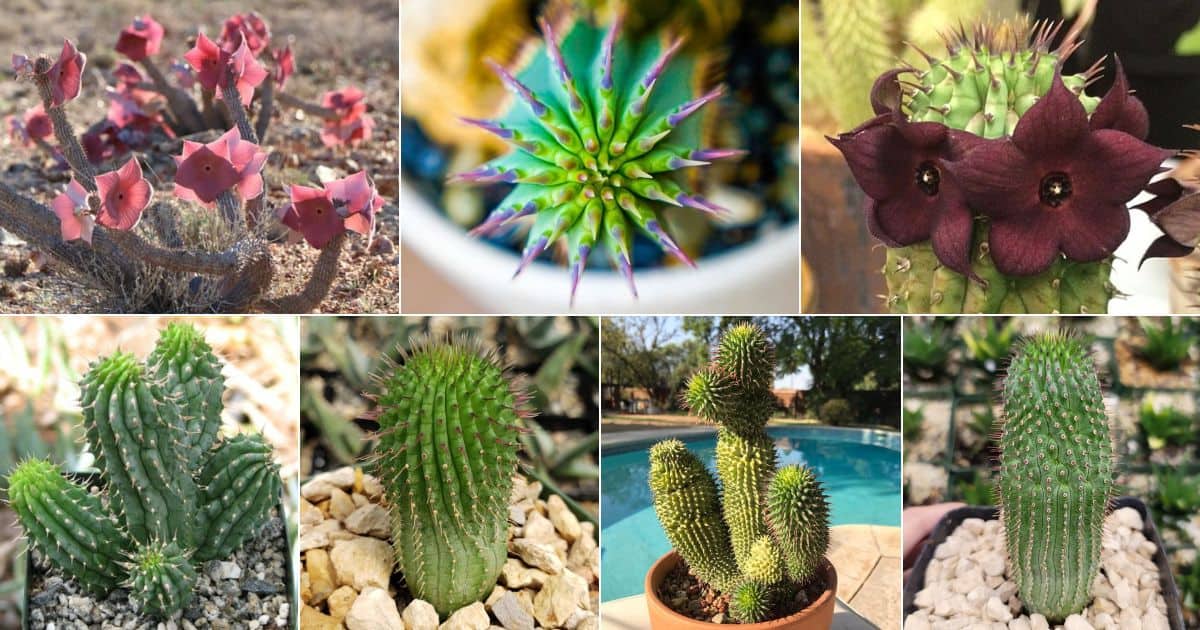
In the local cultures that surround the native habitat of Hoodia gordonii, they use the plant not only as an appetite suppressant during times of famine but also use the plant as a small source of hydration.
Because Hoodias are hard to get a hold of and identify, this post includes scientifically approved species that you can actually access at local plant stores or find online. Let’s begin!
Jump to:
1. Hoodia alstonii
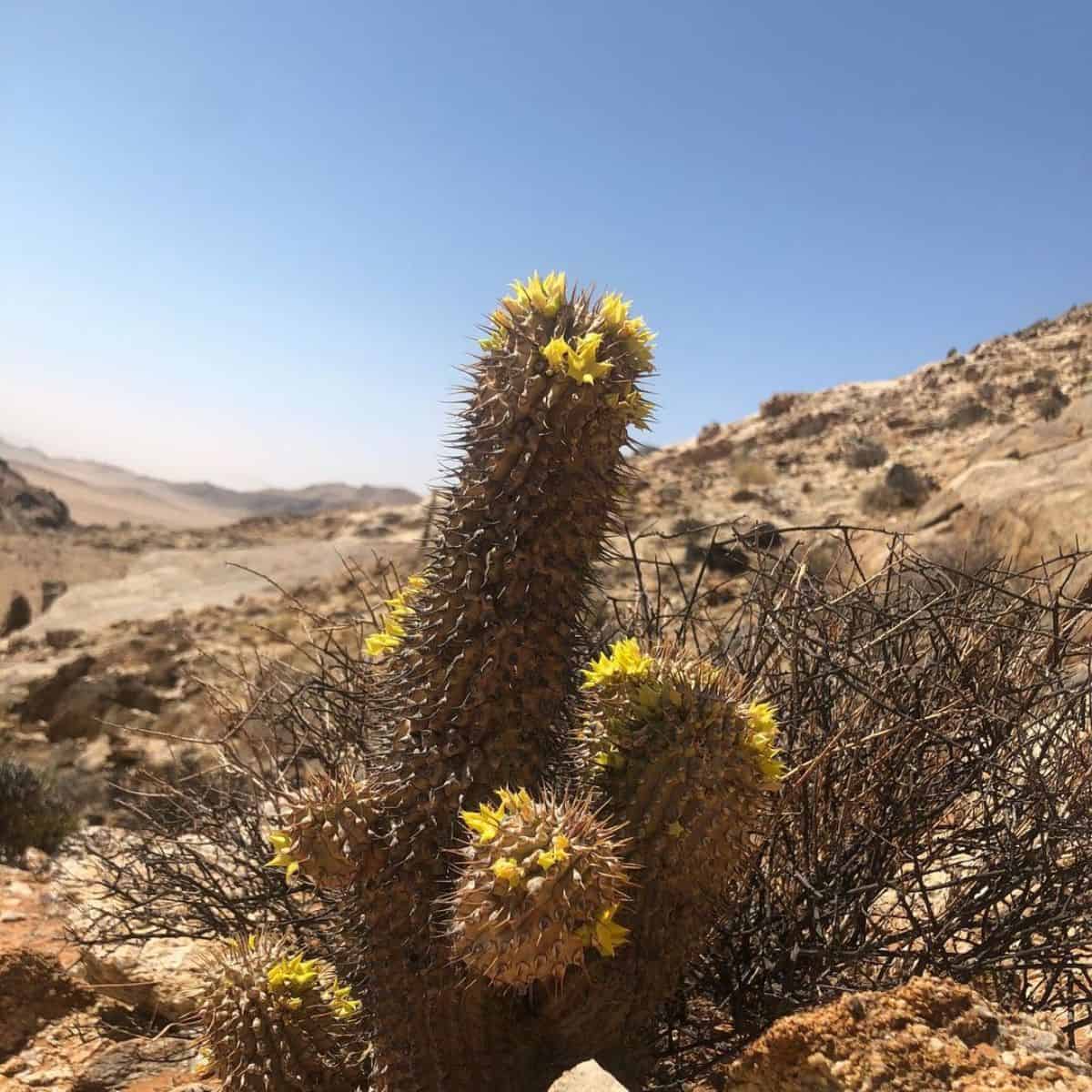
| Stems: | Many stems |
| Spines: | Stiff and sharp |
| Bloom Color: | Yellow |
| Bloom Type: | Star-Shaped |
| Stem Height: | Up to 40 inches |
| Stem Width: | Up to 3 inches |
| Number of Ridges: | 20-22 |
| Watering Schedule: | Soak and dry; water more in the spring and summer |
| Sunlight: | Indoors with direct sunlight or outdoors with partial sunlight |
| Hardiness: | Zone 10 and up |
One of the easiest ways to tell hoodia species apart is by looking closely at their flowers. Some have thinner flower petals, such as H. alstonii, and others will have thicker petals. The star-shaped flowers rest right against the edge of the spines that line each ridge atop a tubercle. The flowers collect at the top of the stems, making them seem like they glow yellow.
2. Hoodia currorii
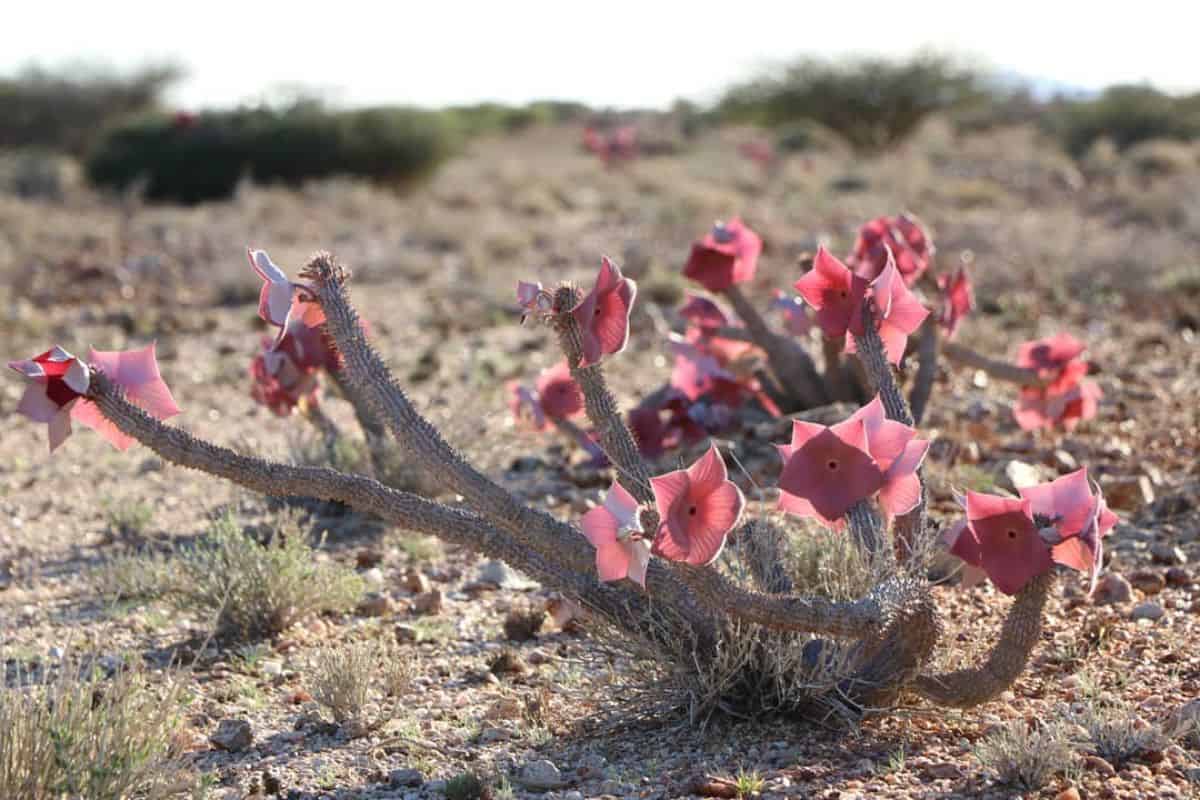
| Stems: | Clumping Stems |
| Spines: | .5 inch spines |
| Bloom Color: | Rose gold with purple hairs |
| Bloom Type: | Circular |
| Stem Height: | 32 inches |
| Stem Width: | 3 inches |
| Number of Ridges: | 11-24 |
| Watering Schedule: | Follow the soak-and-dry method |
| Sunlight: | Full to partial sun |
| Hardiness: | Zone 10 and up |
Unlike others in this genus, H. currori can be grown from cuttings! Generally speaking, most hoodias are going to be difficult to propagate from cuttings. What also sets this species apart from the others is the way the flowers tend to take on a triangular shape as they get older. They are five-lobed flowers that are fused until the tip. Like most others in this genus, it gives off a foul odor.
3. Hoodia flava
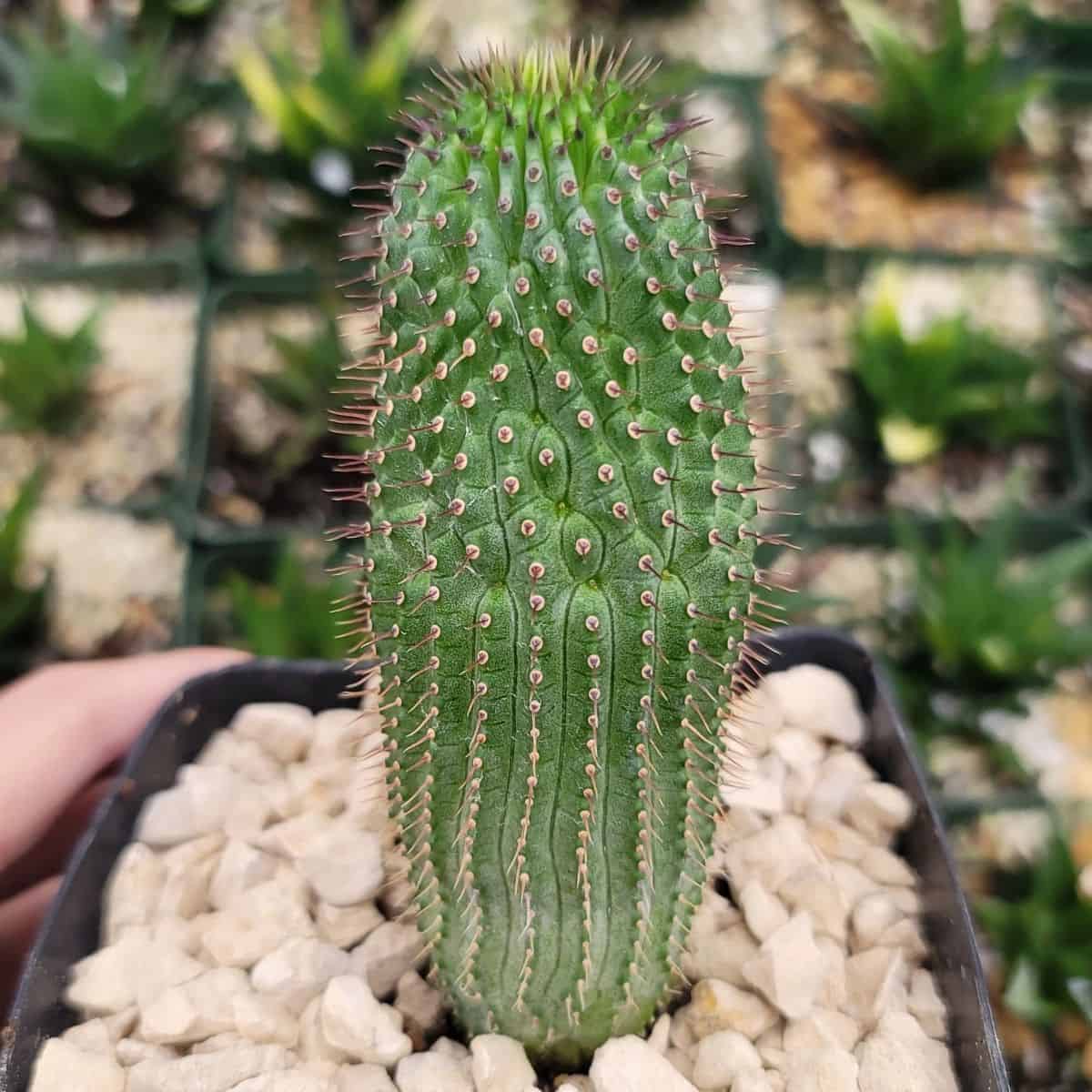
| Stems: | Clumping stems (three or more) |
| Spines: | Hard and slightly curved, brown or black in color |
| Bloom Color: | Yellow-green |
| Bloom Type: | Star-shaped |
| Stem Height: | Up to 50 cm |
| Stem Width: | Up to 7 cm |
| Number of Ridges: | 18-31 |
| Watering Schedule: | Follow the soak-and-dry method |
| Sunlight: | Full to partial sun |
| Hardiness: | Zone 10 and up |
What makes the species unique is that it will grow on its own but will also grow inside of other bushes. As a clumping and bushing succulent, it tends to grow from a single stem. the flowers are extremely interesting as they are double-layered. the back layer of the flower is yellow-green while the upper layer containing the stamens is a more butter yellow. Its distinct flower makes this one of the easier species to identify.
4. Hoodia triebneri
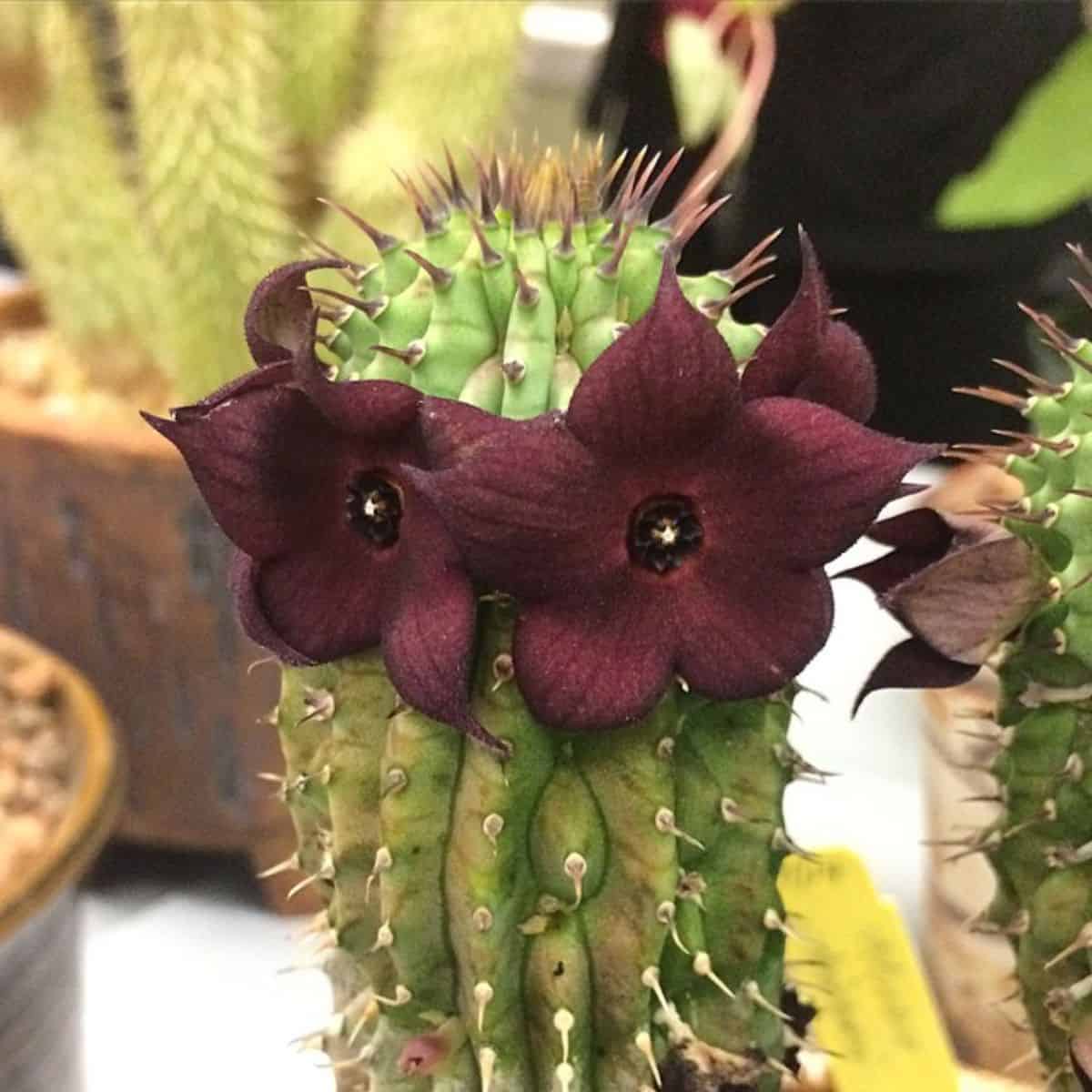
| Stems: | Clumping stems |
| Spines: | Dark, hard spines |
| Bloom Color: | Black with some red or purple |
| Bloom Type: | Bell shape |
| Stem Height: | Up to 30 cm |
| Stem Width: | Up to 4 cm |
| Number of Ridges: | 12-14, rarely 16 |
| Watering Schedule: | Follow the soak-and-dry method |
| Sunlight: | Full to partial sun |
| Hardiness: | Zone 10 and up |
Probably one of my favorites, this species is known for its tiny flowers that are barely half an inch wide. These small bell-shaped flowers are generally a dark purple that can seem almost black. Another interesting aspect about this species is that they will grow up to 30 different stems from a single clump. More often than not, the species can be found underneath acacia trees and is native to Namibia.
5. Hoodia rustica
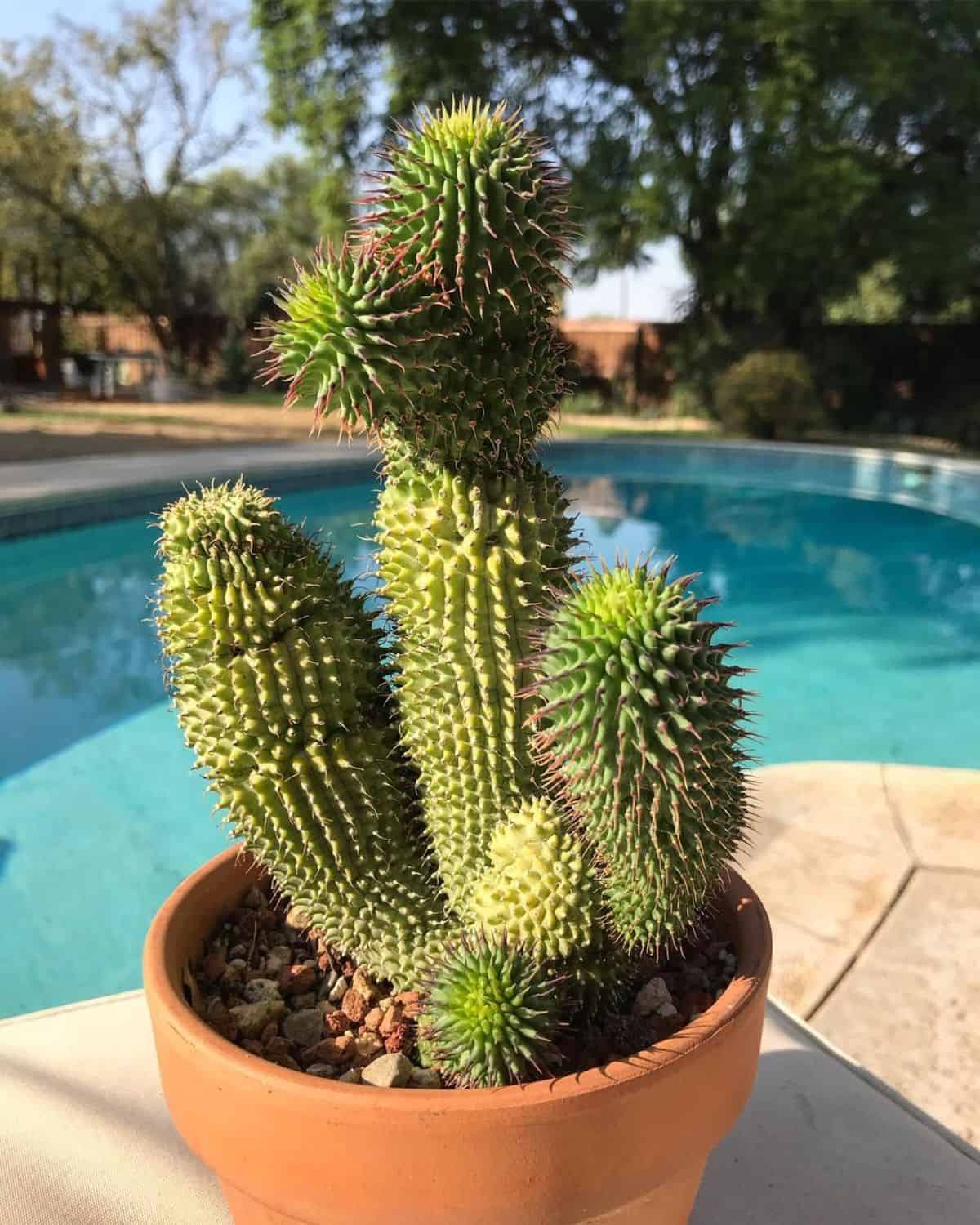
| Stems: | Clumping |
| Spines: | Short hooked spines |
| Bloom Color: | Red with yellow center |
| Bloom Type: | Fused Star |
| Stem Height: | 40 cm |
| Stem Width: | 2-3 inches |
| Number of Ridges: | 18-20 |
| Watering Schedule: | Follow the soak-and-dry method |
| Sunlight: | Full to partial sun |
| Hardiness: | Zone 10 and up |
Also known as Hoodia officinalis, this species is one of the easiest to find, and it is one of the most widely cultivated species as well. More often than not, breeders attempt to make more stable hybrids using the species as a parent plant. It is fascinating to watch the species grow from a tiny shrublet to a full-size shrub. when young, the stems are rather thin and seem to be more Spike than the stem. As they get older, the stems and spines seem far more proportionate.
6. Hoodia pilifera
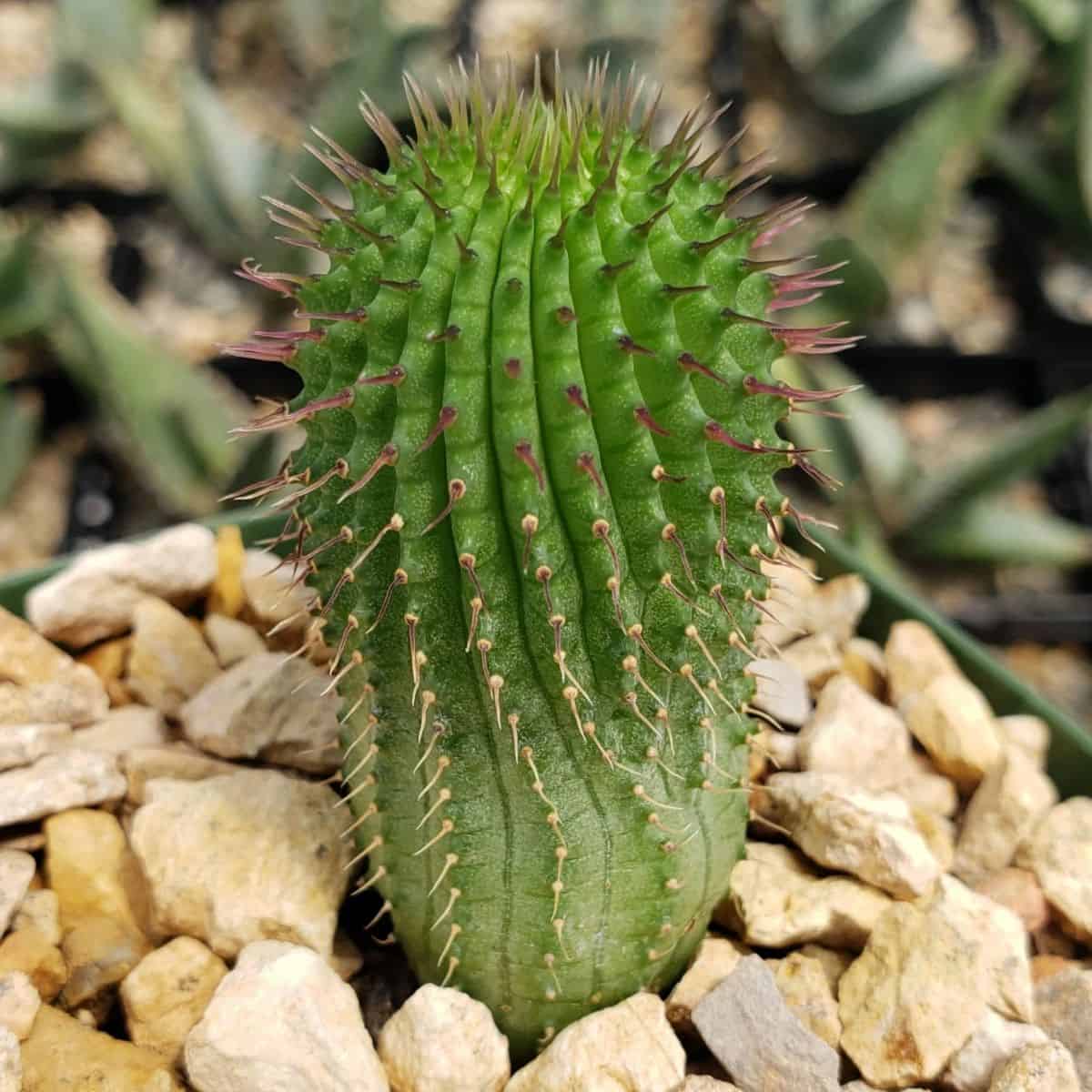
| Stems: | Clumping stems up to 2m in width |
| Spines: | Flexible spines |
| Bloom Color: | Deep purple-black |
| Bloom Type: | Saucer shaped |
| Stem Height: | Up to 80 cm |
| Stem Width: | Up to 6 cm |
| Number of Ridges: | 21-34 |
| Watering Schedule: | Follow the soak-and-dry method |
| Sunlight: | Full to partial sun |
| Hardiness: | Zone 10 and up |
Unlike others in this genus, H. pilifera is one to keep an eye on. In the wild, the flowers look like black mold is trying to take over the entire shrub. but upon closer inspection, it's easier to see that they are fused Stars that take on a saucer-like shape.
7. Hoodia pedicellata
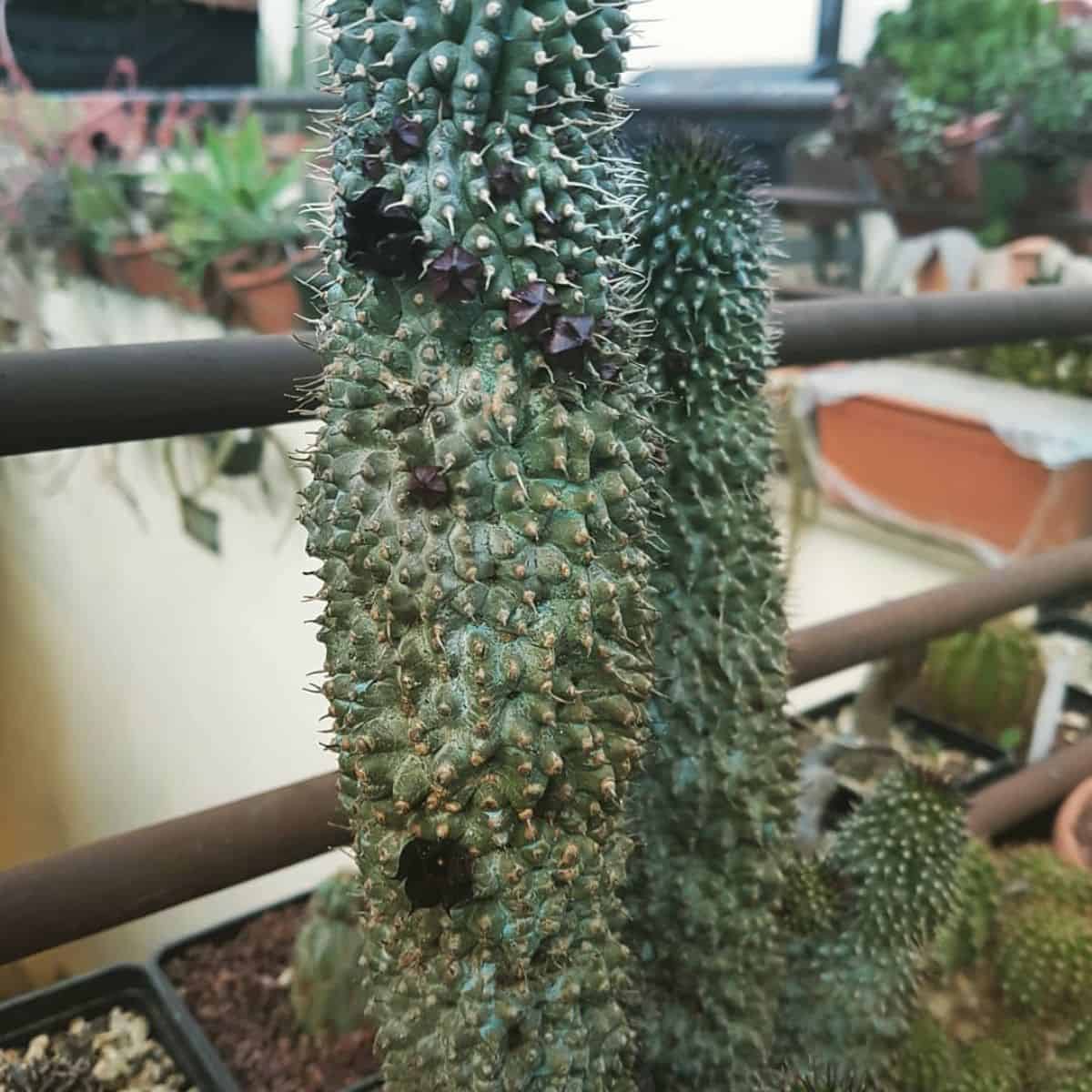
| Stems: | Up to 20 clumping stems |
| Spines: | Spineless |
| Bloom Color: | Red, maroon, or yellow |
| Bloom Type: | Star-shaped |
| Stem Height: | Up to 250 mm |
| Stem Width: | Up to 50 mm |
| Number of Ridges: | 11-20 |
| Watering Schedule: | Follow the soak-and-dry method |
| Sunlight: | Full to partial sun |
| Hardiness: | Zone 10 and up |
An intriguing species, you can find flowers of all colors on this hoodia. Most hoodias will have one specific flower color, such as dark maroon, black, or the more common reds. Instead, you'll find all of these colors on H. pedicellata. Not only is it one of the most intriguing and beautiful, but it is also one of the hardest to grow in this genus. Most gardeners suggest starting from seed and moving from there; cuttings usually end up dying very quickly.
8. Hoodia parviflora
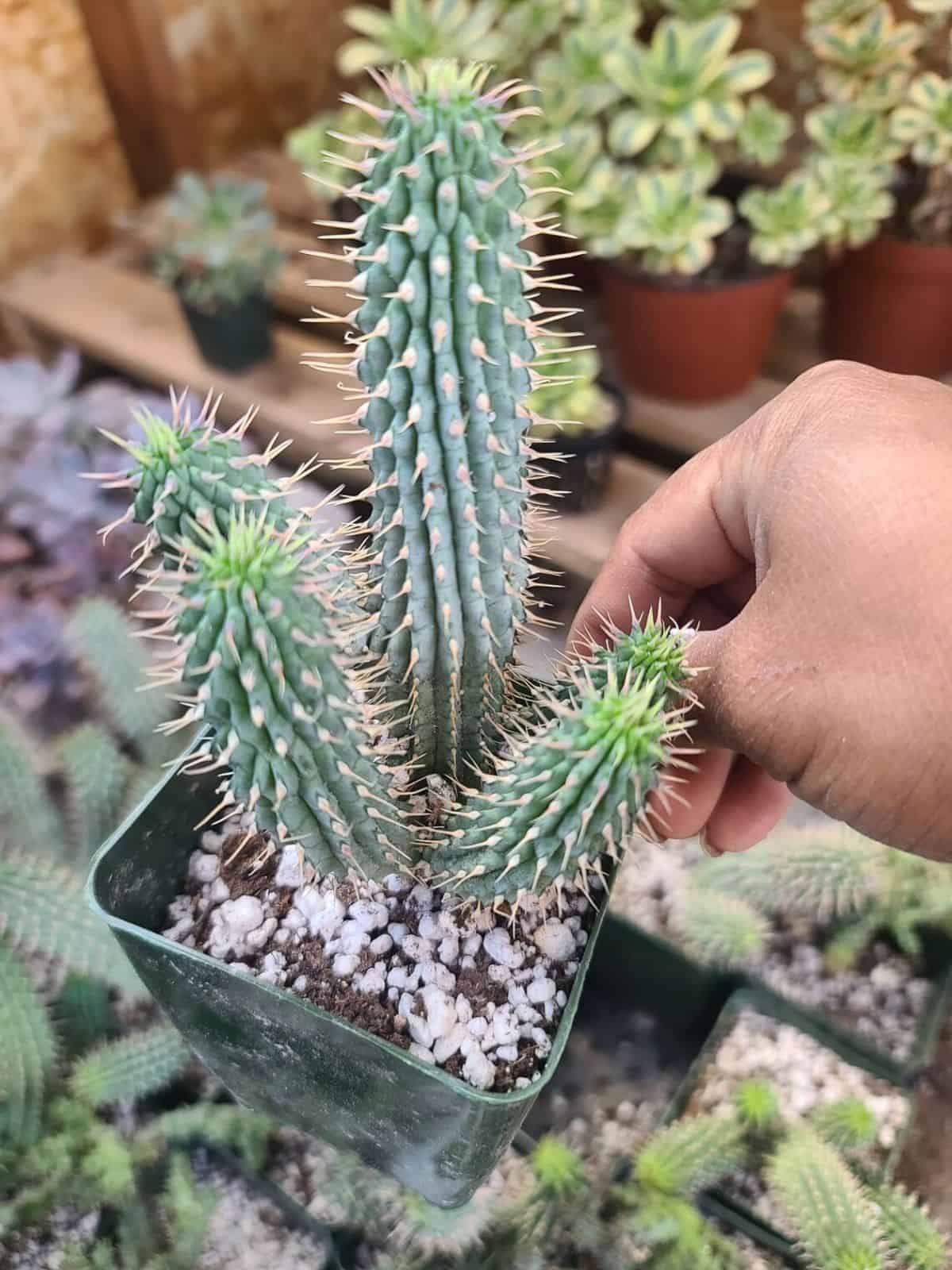
| Stems: | Unbranched Stem |
| Spines: | Short, dark brown spines |
| Bloom Color: | Deep Buttery Yellow |
| Bloom Type: | Saucer |
| Stem Height: | 6 feet and up |
| Stem Width: | Indeterminate |
| Number of Ridges: | 10 or more |
| Watering Schedule: | Follow the soak-and-dry method |
| Sunlight: | Full to partial sun |
| Hardiness: | Zone 10 and up |
Also known as the Tree Hoodia, H. parviflora is the largest species in this genus. It is known to help with insulin resistance, and it has recently been used in several studies to see if it can help with the effects of diabetes. The flowers are also saucer-shaped, but when you look closer, they are the typical fused, five-pointed star. An interesting aspect of the coloration of the flowers on the species is that you can find yellows, oranges, and even flesh tones. however, unlike the H. pedicellata, you won't find all of the colors existing on the same specimen.
9. Hoodia mossamedensis
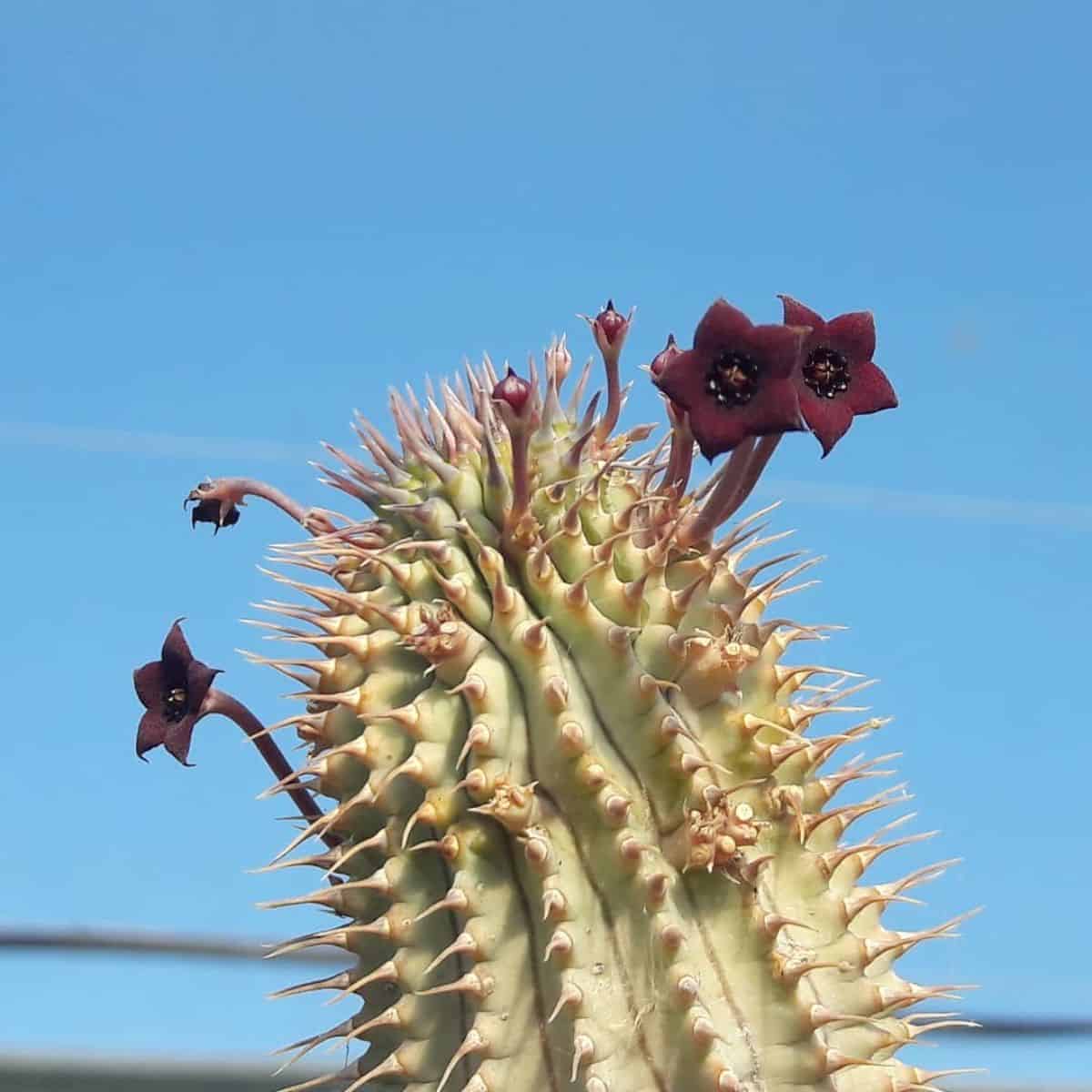
| Stems: | 1 - 4 stems |
| Spines: | Brown and up to 6 mm long |
| Bloom Color: | Velvety Purple-brown |
| Bloom Type: | Star-shaped |
| Stem Height: | Up to 30 cm |
| Stem Width: | Up to 5 cm |
| Number of Ridges: | 16-20 |
| Watering Schedule: | Follow the soak-and-dry method |
| Sunlight: | Full to partial sun |
| Hardiness: | Zone 10 and up |
Native to Angola, this species is rather interesting because it tends to take on more gray tones than others. In some cases, it can appear white! The flowers of H. mossamedensis are far more velvety and thicker than others in this genus. They tend to stay a dark purple-brown that can sometimes appear black. You won't find this species growing very many stems as it is one of the smallest shrublets in the genus.
10. Hoodia grandis
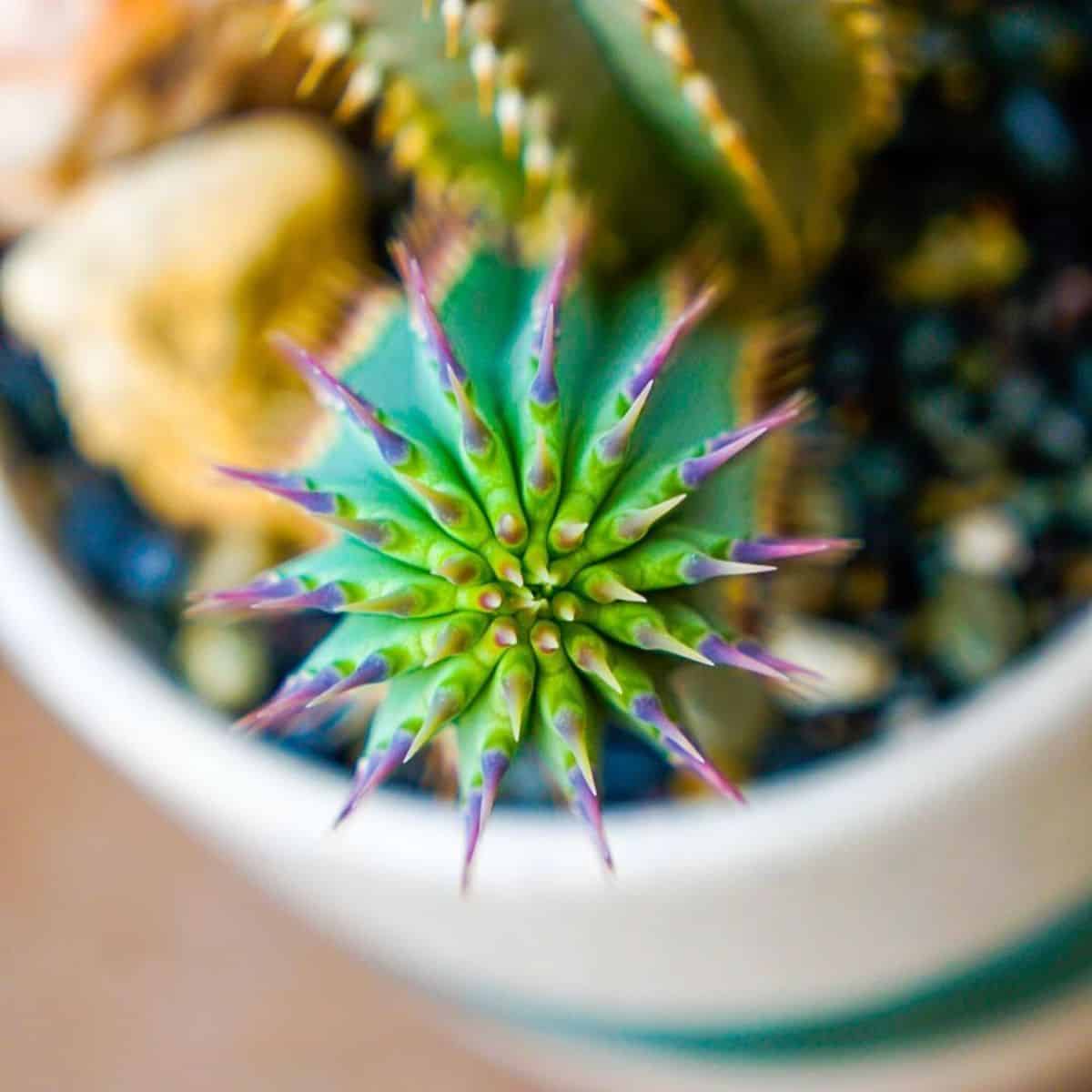
Buy it from:
| Stems: | Shrub-like clustering stems |
| Spines: | Short, brown, and slightly hooked |
| Bloom Color: | Brown, pink, yellow |
| Bloom Type: | Star |
| Stem Height: | Up to .6 m tall |
| Stem Width: | Up to .5 m |
| Number of Ridges: | Around 18 |
| Watering Schedule: | Follow the soak-and-dry method |
| Sunlight: | Full to partial sun |
| Hardiness: | Zone 10 and up |
Another species that is fond of growing inside of another plant, H. grandis is one of the largest in the genus other than the tree hoodia. The blooms can vary greatly from browns to pinks to yellows, and the spines are more hooked than others in this genus. it does tend to Cluster, and the spines are very pronounced atop dramatically waving tubercles.
11. Hoodia gordonii
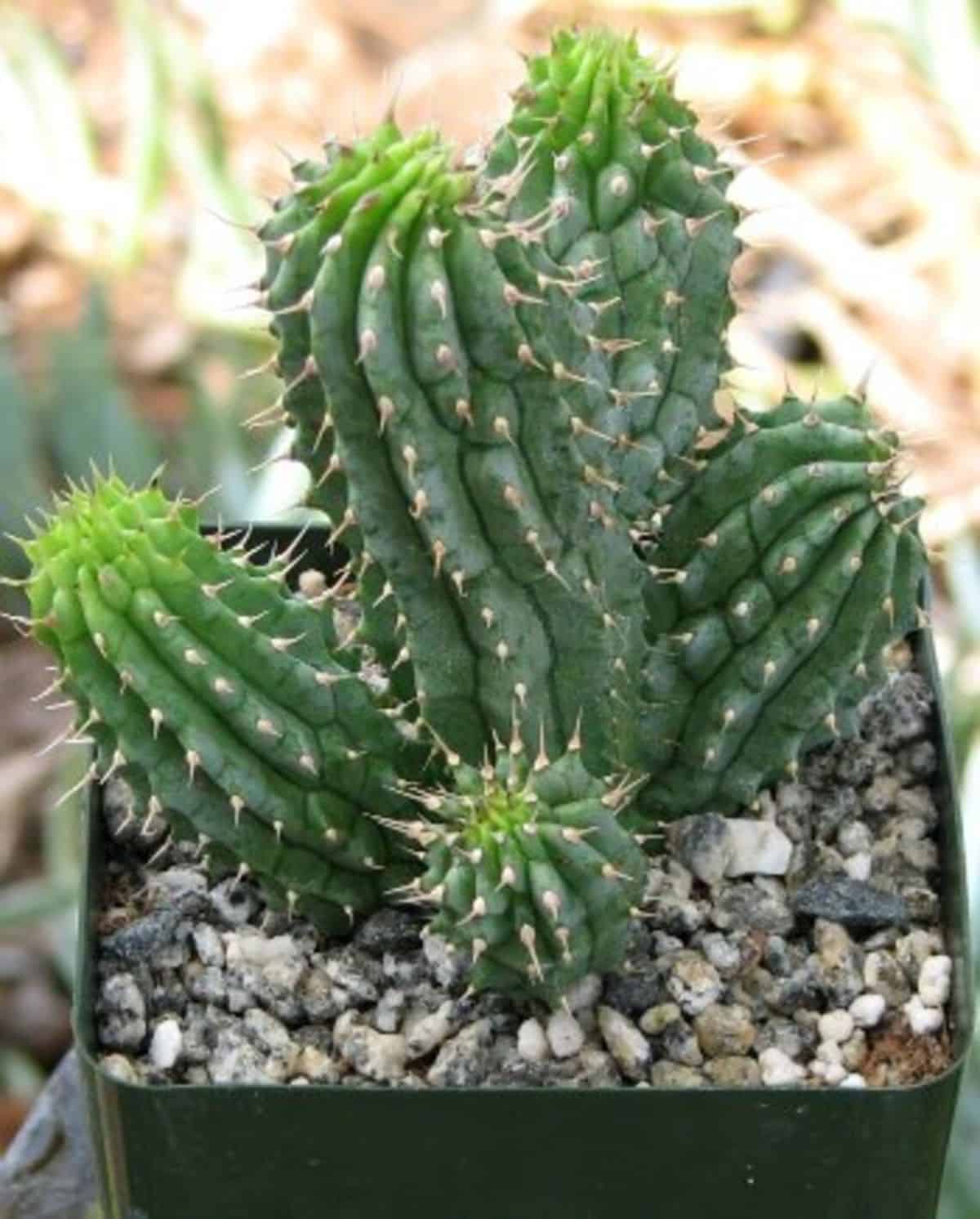
Buy it from:
| Stems: | Clumping shrub |
| Spines: | Up to 12 mm long |
| Bloom Color: | Pale fleshy color |
| Bloom Type: | Circular with five lobes |
| Stem Height: | 1 m |
| Stem Width: | Up to 50 mm thick |
| Number of Ridges: | 11-17 |
| Watering Schedule: | Follow the soak-and-dry method |
| Sunlight: | Full to partial sun |
| Hardiness: | Zone 10 and up |
Finally, one of the most researched species in the hoodia genus. Gordonii has been used for years as an appetite suppressant both in the medical field and for personal use. Historically it has been used as a source of water, as have other species in this genus. What makes this species almost creepy is that the flowers only take on a fleshy tone. So instead of the beautiful reds, yellows, oranges, and blacks of the others in this genus, the most researched and most famous has pale skin-tone flowers.

